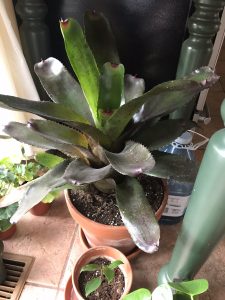
Perhaps you can help, I will try to send photos. We have two plants, one we think is a type of Yucca. Several of the lower leaves are turning yellowish and are drooping. Is this normal? The other plant has thick leaves with “prickles” on the edges, the tips of which are slightly curling and one leaf is turning brown and mottled. We don’t know what plant it is.
Thank you for contacting the Toronto Master Gardeners.
The plant in your photo is a tank type bromeliad. Bromeliads are a family of plants (Bromeliaceae, pineapple family) native to tropical North and South America. Tank bromeliads have leaves that form a reservoir to hold water at their base.
The sharp teeth on the margin of the leaves places your plant in the Aechmea genus. Plants in this genus have broadly bowl-shaped rosettes with arching leaves. The leathery, strap-like leaves may be solid, spotted, striped or banded, but all have sharp teeth on the margins.
When watering tank type bromeliads , the tank should be kept filled with water at all times. Be careful when you fill the tank not to let water soak the soil. Bromeliads are prone to root rots if the soil is kept wet. Flush the tank periodically by pouring fresh water into it, inverting and filling again. This will prevent stagnation and buildup of mineral salts. To prevent the build up of salts, distilled water or rain water is best when watering.
Brown curling tips on your bromeliad plant is a sign that your plant requires water. Tank type bromeliads tend to concentrate their moisture supply in the center of the plant where new growth takes place, leaving the outer edges of the leaves, particularly the lower leaves, short on water. As a result, the leaves begin to lose integrity becoming thin and flaky around the edges instead of stiff.
Even though bromeliads drink from the tank, their roots like to stay moist. If the soil around the plant is dry, give the plant just enough water to keep the soil moist without saturating it. If the soil becomes too wet, the plant can develop root rot quickly.
Bromeliads general do not have problems with pests, however if a dark mold develops on the leaves, this could be a sign of scale, which appear as hard brown bumps in the leaves. If scale is visible apply insecticidal soap which is available at your local garden center being careful to follow the instructions on the label. The mold can be removed from the leaves with mild soapy water.
Good Luck with your plant.

